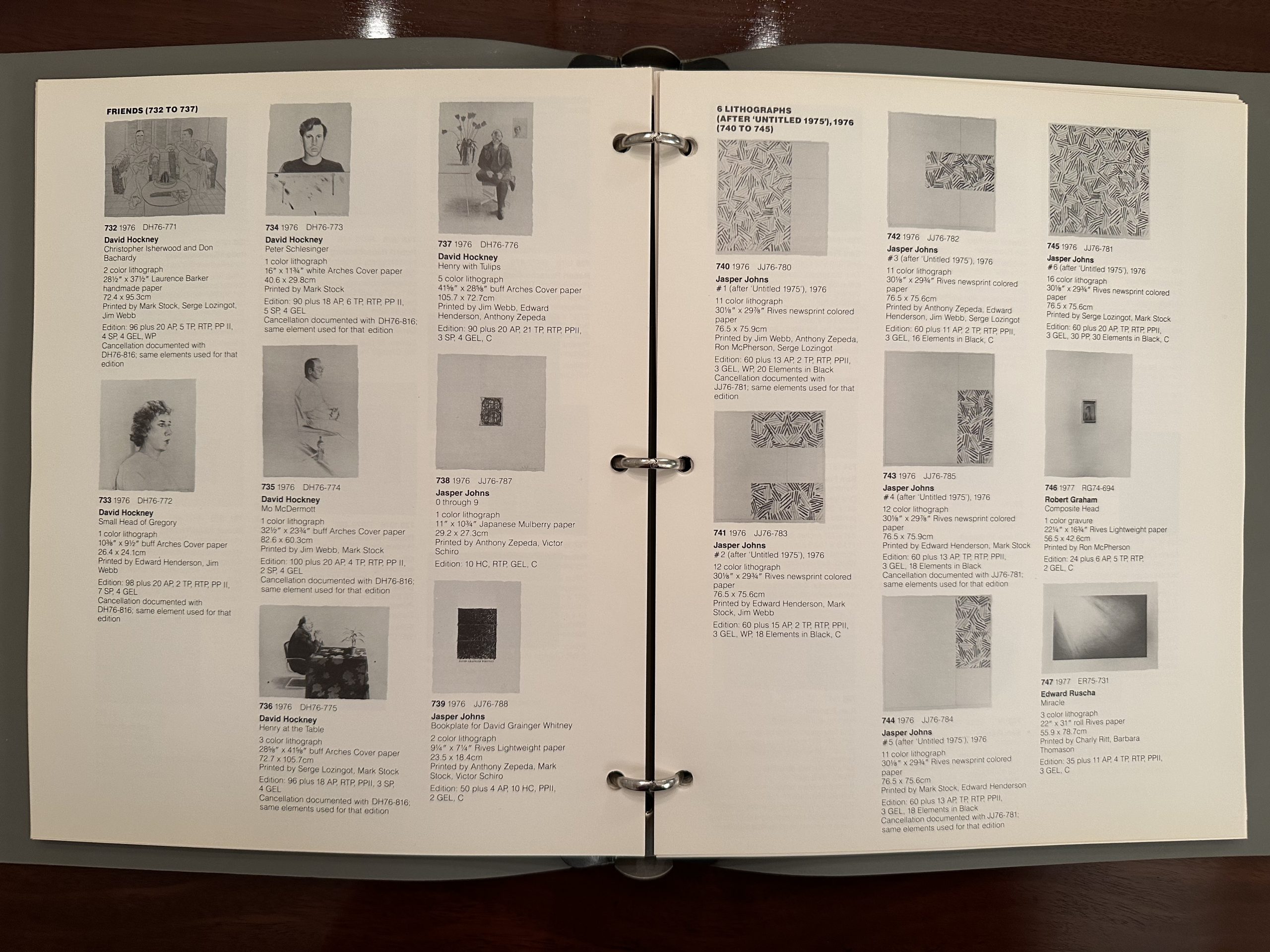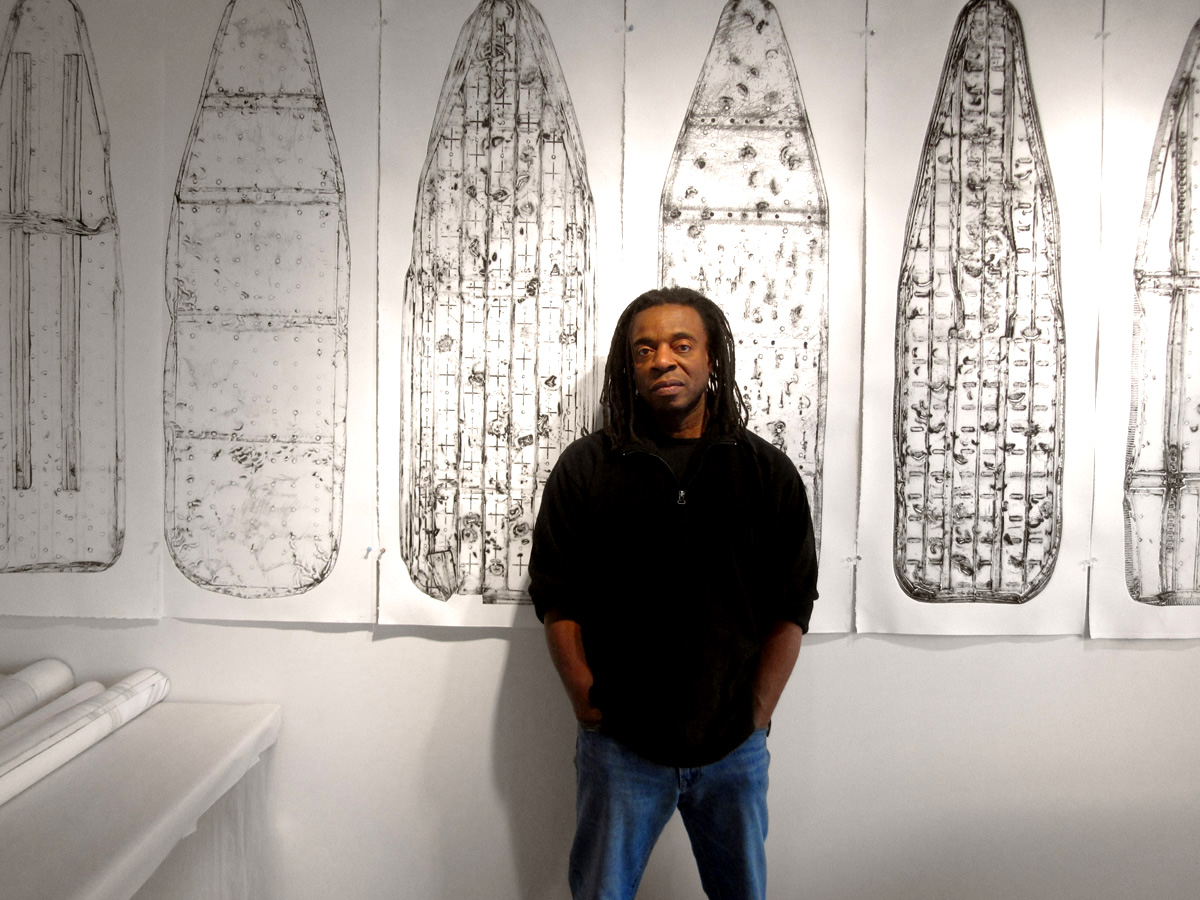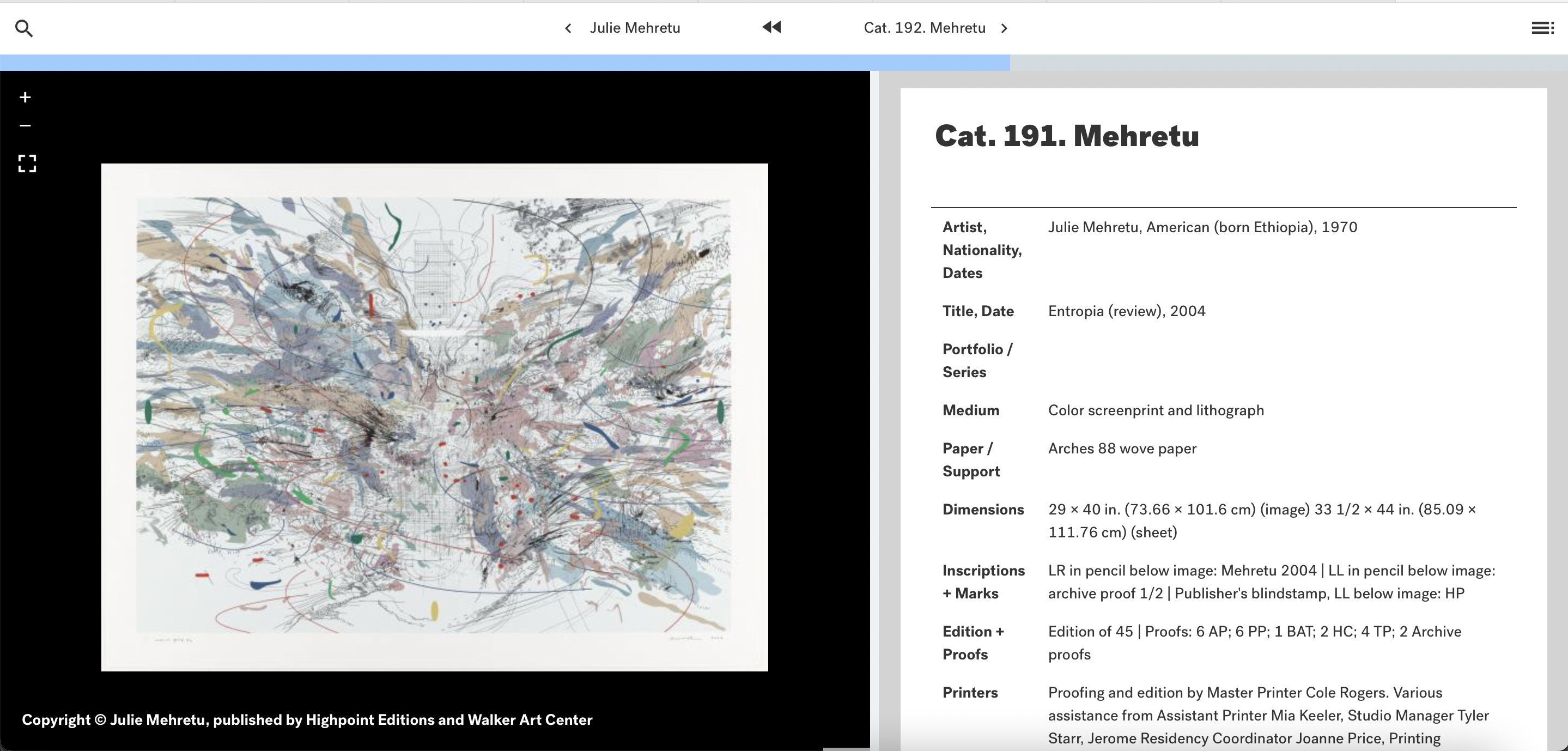Highpoint Editions: A History & Catalogue, 2001–2021
PDF: Weyl, review of Highpoint Editions
Highpoint Editions: A History & Catalogue, 2001–2021
edited by Dennis Michael Jon
Minneapolis: Minneapolis Institute of Art, 2021. 781 pp.; color illus. Published with Quire (ISBN TK; OCLC 1280416297), https://artsmia.org/highpoint-editions
Despite the predominant use of “catalogue raisonné” to describe a compendium of a single artist’s lifetime works, the term’s origins in the seventeenth and eighteenth centuries encompassed more variety, from scientific publications to sales and auction catalogues.1 Scholars of printmaking have long recognized the benefit of documenting the output of print publishers, which can encompass many different artists. Although some of the earliest catalogues raisonnés focused on the graphic arts, the first covering a print publisher did not appear until the mid-twentieth century.2 Since the advent of collaborative printmaking studios in the 1960s, the number of these resources has proliferated.3 Searching for “print publisher” in the Print Council of America’s Index to Print Catalogues Raisonnés (IPCR) yields many results.4
As the field of digital catalogues raisonnés has developed over the last twenty years, catalogues for print publishers represent an important area of innovation.5 The National Gallery of Art’s online catalogue raisonné for Gemini G.E.L. (2001) was likely the first digital catalogue raisonné.6 The e-publication transformed the loose-leaf version of Gemini’s catalogue raisonné, released in batches between roughly 1971 and 1988 (fig. 1).7

Highpoint Editions: A History & Catalogue, 2001–2021, a digital publication by the Minneapolis Institute of Art (Mia), is a new entry in this rich tradition. In particular, Mia’s project demonstrates the advantages of Quire, an open-source digital publishing tool developed by Getty Publications. Drawing on my own experience as a beta tester of Quire when it first launched beta access in 2018, I believe that Quire offers many benefits over other online platforms for presenting collection catalogues and catalogue raisonné research.
The genesis for Quire dates back to 2009 when the Getty Foundation launched the Online Scholarly Catalogue Initiative (OSCI), an effort by eight museums to investigate the possibility of developing digital tools to present otherwise costly physical collection catalogues.8 Over the next several years (see Quire’s development timeline), a team at Getty Publications spearheaded the effort to build Quire, which launched beta access in 2018.9 Quire’s strengths are rooted in several factors:
- Accessibility: Quire has no upfront costs or ongoing maintenance fees beyond normal web hosting.
- Stability: Unlike content management systems (CMS), Quire sites are “static” and not reliant on custom code that could expire or break. There are many advantages of static site generation for scholarly projects.
- Discoverability: Projects can be found with search engines and platforms from WorldCat to Amazon.
- Versatility: Quire produces visually rich, book-like projects of any size—from major museum catalogues and scholarly journals to student projects. Quire’s community showcase conveys this range.
Quire offers a variety of page types allowing users to structure their content into a book-like product. Content can be organized into menus and submenus, for which Quire provides many possible configurations.
Highpoint Editions showcases the potential of Quire as a robust digital publishing platform and highlights its functionality as a tool for creating online catalogues raisonnés. In December 2020, Mia acquired the Highpoint Editions Archives (HEA), the publishing arm of the Minneapolis-based Highpoint Center for Printmaking. Spanning twenty years, HEA includes approximately three hundred editioned prints by thirty-eight artists as well as one thousand ancillary items: preparatory drawings, trial and color proofs, and unrealized projects. During the challenging months of the pandemic, Mia’s staff embarked on an ambitious project to catalogue HEA, prepare a major scholarly apparatus with essays by Mia curators and invited scholars, write thirty-eight short artist’s biographies, and present it all with Quire.10
Highpoint Editions uses Quire’s essay layout to present four scholarly contributions, which cover the innovative, thought-provoking, and technically challenging prints that leading contemporary artists have produced at Highpoint since 2001. In the anchor text, Dennis Michael Jon, Mia’s associate curator of global contemporary art, charts the history of Highpoint Editions and its function within the ecosystem of Highpoint Center for Printmaking. Jill Ahlberg Yohe, Mia’s associate curator of Native American art, examines four Indigenous artists invited to work at Highpoint Editions: Julie Buffalohead, Andrea Carlson, Brad Kahlhamer, and Dyani White Hawk. Jennifer Roberts presents an extended discussion of Willie Cole’s complex series of twenty-eight prints pulled from antique ironing boards (fig. 2). Text for each essay is formatted in Markdown, a plain-text language that converts easily to HTML, and images or other multimedia are inserted in-text with Quire shortcodes. Quire also produces fully formatted captions and credit lines using a metadata file (figures.yaml). Also significant for scholars, Quire supports fully formatted footnotes and bibliographies.

The catalogue raisonné of Highpoint Editions is built using the entry page type, which provides for many customizations. As with captions, Quire entry pages display information based on a metadata file called objects.yaml. Quire’s entry pages are incredibly flexible because users can display whatever metadata they like, including “collections” of recipes, museum collection guides, or spotlights on collection artists.11 As a beta tester, I used Quire to publish a “collection” of artists’ biographies that supplement the research in my book The Women of Atelier 17 (2019).12
In Highpoint Editions, 298 entries (compiled by curatorial assistant Kristin Lenaburg) comprise nearly 90 percent of the publication.13 Structured alphabetically, short biographies (authored by curatorial fellows Marla J. Kinney and Ian Karp) precede each artist’s catalogue entries and provide descriptions about their collaboration(s) with Highpoint Editions. A three-year collaboration with Julie Mehretu, for example, yielded the artist’s first significant prints—the spectacular Entropia (review) (cat. no. 191; fig. 3), a thirty-two-color screen print and lithograph, and its related tonal lithograph, Entropia: Construction (2005; cat. no. 192). Mehretu’s publications are especially important, as they firmly established Highpoint Editions on the international stage.

Quire’s capacity to generate book-like essay layouts across multiple outputs is distinctive compared to other popular platforms for building digital catalogues raisonnés, such as panOpticon, Cahiers d’Art Institute (CDAI), and Navigating.art.14 Because Quire is built on static site generation, all the pages and structure that users create for their impressive Quire websites (optimized for desktop browsers and mobile devices) seamlessly convert into other outputs: e-books (EPUB/MOBI) and fully formatted PDFs that are downloadable or could be used for print-on-demand books (here is the PDF for Highpoint Editions). Quire users can turn their websites into professional-looking books “in one click” (actually, because Quire uses the command-line shell—Terminal on a Mac—users will type the command quire pdf to generate this output).
Reviewing Quire projects online provides readers with the most interactivity—clicking links, listening to audio, watching video content, and zooming in on high-resolution images—that do not translate into the PDF or e-book formats. In Highpoint Editions, readers can jump between catalogue entries and Mia’s collection database to review the auxiliary material (fig. 4). The PDF output enables readers to download any part of a Quire project without fighting with wonky website formatting (how many of us have tried to capture a webpage using “print to PDF” and gotten unreadable results?).
Fig. 4. Screencast, scrolling through Highpoint Editions to see essays and catalogue entries. Courtesy of the reviewer
Despite its learning curve, Quire is a wonderful tool for those who are curious to acquire new skills. Beginners can use the standard Quire template “out of the box,” and more advanced users could tinker with customizing code (at Mia, in-house designer Kristina Thayer coordinated Highpoint Editions). Getty Publications offers plentiful documentation for new users, hosts once-a-month office hours for current or prospective users, and has an active community forum on GitHub.
In its present version, Quire will not supplant other platforms for publishing digital catalogues raisonnés. On the backend, working in a proprietary database (i.e., panOpticon, CDAI, or Navigating.art) seamlessly facilitates updating records and pushing changes to an online project. Unlike Quire, however, these platforms all require ongoing subscriptions to host and support the projects’ websites. To update a Quire catalogue, users must manually update the objects.yaml file or re-export data from Excel. The alphabetical arrangement of entries in Highpoint Editions may prove cumbersome for future updates. There will be numerical jumps anytime a returning or new artist publishes with Highpoint Editions. A chronological sequence might be more advisable. Online readers may find the ability to view all catalogue entries and apply filters (by artist, medium, date range, physical dimensions) lacking in Quire’s current version, though its developers plan to introduce filters in future updates.15 Intriguingly, the Wildenstein Plattner Institute, a major publisher of digital catalogues raisonnés, plans to splice Quire into its revised catalogue raisonné for Claude Monet (forthcoming fall 2023), fusing Quire’s strength for presenting scholarly essays and Navigating.art’s robust database.16
Digital catalogues raisonnés have the potential to share specialized knowledge with a wide community. Printed catalogues raisonnés are costly, and research libraries are often the only institutions to purchase copies, which raises geographical challenges and issues of access. Many online catalogues raisonnés are completely free, but some gate access with required registration or limit free review to a “basic” version, with “expanded access” available with an annual subscription.17 CDAI’s e-catalogues are quite expensive, with prices starting at $300 per year. Theoretically, future Quire catalogues raisonnés could exist behind a paywall, but that feels counter to Quire’s roots as an open-source platform. For nonprofits like Mia and Highpoint Center for Printmaking, which are committed to inclusion and lowering barriers, Quire offers a powerful tool for sharing broad and equitable access to twenty years of Highpoint Editions.
September 10, 2023: This article was edited to reflect the correct spelling of Dennis Michael Jon’s name.
Cite this article: Christina Weyl, review of Highpoint Editions: A History & Catalogue, ed. Dennis Michael Jon, Panorama: Journal of the Association of Historians of American Art 9, no. 1 (Spring 2023), https://doi.org/10.24926/24716839.17138.
Notes
- Antoinette Friedenthal, “Defining the Oeuvre, Shaping the Catalogue Raisonné,” in The Challenge of the Object, 33rd Congress of the International Committee of the History of Art, ed. G. Ulrich Grossmann and Petra Krutisc (Nuremberg: Verlag des Germanischen Nationalmuseums, 2013), 2:723–27. ↵
- Una Johnson’s study of publisher Ambroise Vollard may represent the first such effort: Una Johnson, Ambroise Vollard, Éditeur, 1867–1939: An Appreciation and Catalogue (New York: Wittenborn, 1944); reprinted as Ambroise Vollard, Éditeur: Prints, Books, Bronzes (New York: Museum of Modern Art, 1977). Interestingly, the 1944 publication uses the term “catalogue,” while the reprint employs “catalogue raisonné.” In this brief historiography, it is worth mentioning Edmond Sagot (1857–1917) who regularly published catalogues of his editions beginning in 1884. Thank you to members of the Association of Print Scholars for generously responding to my query via their listserv regarding the history of catalogues raisonnés for print publishers. ↵
- At Tamarind Lithography Workshop, June Wayne established more robust documentation standards, which likely facilitated the creation of many catalogues for print publishers. ↵
- Timothy A. Riggs, expanded and updated by Lauren B. Hewes and Nicole Simpson, The Print Council Index to Oeuvre-Catalogues of Prints by European and American Artists, 2nd ed. (Print Council of America 2000), https://printcouncil.org/search. Cognizant of the catalogue raisonné’s traditional definition, some scholars have chosen the term “index” to describe compilations about print publishers; see “Index of Associated American Artists print, ceramics and textile designs, published by the Beach Museum of Art of Kansas State University, now available,” Kansas State University Press Release, August 24, 2016, https://www.k-state.edu/media/newsreleases/2016-08/aaaindex82416.html. ↵
- As of this review’s publication, the International Foundation for Art Research (IFAR) lists 180 published “online only” and an additional 174 digital projects “in production; see “Catalogues Raisonnés,” International Foundation for Art Research, accessed May 16, 2023. ↵
- Gemini G.E.L. Online Catalogue Raisonné, 2nd ed. (Washington, DC: National Gallery of Art, 2011), https://www.nga.gov/gemini/home.htm; Mollie Echeverría, “The Online Catalogue Raisonné: Challenges of an Emerging Format,” December 5, 2016, paper for Art Librarianship (LIS 667-01) at Pratt Institute, accessed February 15, 2023, http://www.mollieecheverria.com/projects/online-catalogue-raisonnes. ↵
- Thank you to Joni Weyl and Chris Santa Maria for researching the history of Gemini’s loose-leaf catalogue raisonné. ↵
- “Online Scholarly Catalogue Initiative,” Getty, accessed May 16, 2023, https://www.getty.edu/projects/online-scholarly-catalogue-initiative. ↵
- “History,” Quire, accessed May 16, 2023, https://quire.getty.edu/about/history. ↵
- This e-catalogue was Mia’s third Quire project and its largest undertaking, thanks to a Digital Development Award from the Association of Research Institutes in Art History (ARIAH). For Mia’s earlier Quire projects, see LaBouff, Nicole, and Emily Beck, eds., Alcohol’s Empire: Distilled Spirits in the 1700s Atlantic World (Minneapolis: Minneapolis Institute of Art, 2019), https://artsmia.github.io/alcohols-empire; ZumBahlen, Kara, Juline Chevalier, Debra Hegstrom, Ann Isaacson, and Daliya Jokondo, eds. Tour Toolkit: Developing an Inclusive Tour (Minneapolis: Minneapolis Institute of Art, 2019), https://artsmia.github.io/tour-toolkit. ↵
- “Recipes,” in LaBouff and Black, Alcohol’s Empire; Aimee Marcereau DeGalan, ed., French Paintings and Pastels, 1600–1945: The Collections of the Nelson-Atkins Museum of Art (Kansas City, MO: The Nelson-Atkins Museum of Art, 2021), https://doi.org/10.37764/78973; 50X50: Stories of Visionary Artists from the Collection (San José, CA: San José Museum of Art, 2020), https://50×50.sjmusart.org. ↵
- Christina Weyl, The Women of Atelier 17: The Biographical Supplement, last updated 2020, https://atelier17.christinaweyl.com. ↵
- While there are 298 catalogue entries, the director’s foreword indicates that HEA includes 325 “editioned and unique prints” (vii). ↵
- Artifex Press, a major e-catalogue raisonné publisher founded in 2009, is now part of CDAI. ↵
- Erin Dunigan, Community Manager of Quire, personal communication with author, February 8, 2023. ↵
- Caitlin Sweeney, WPI Director of Digital Publications, personal communication with author, March 28, 2023. ↵
- See, for example, Sam Francis Foundation, Sam Francis Online Catalogue Raisonné Project, accessed May 16, 2023, https://cr.samfrancisfoundation.org. ↵
About the Author(s): Christina Weyl is an Independent Curator & Scholar based in New York

